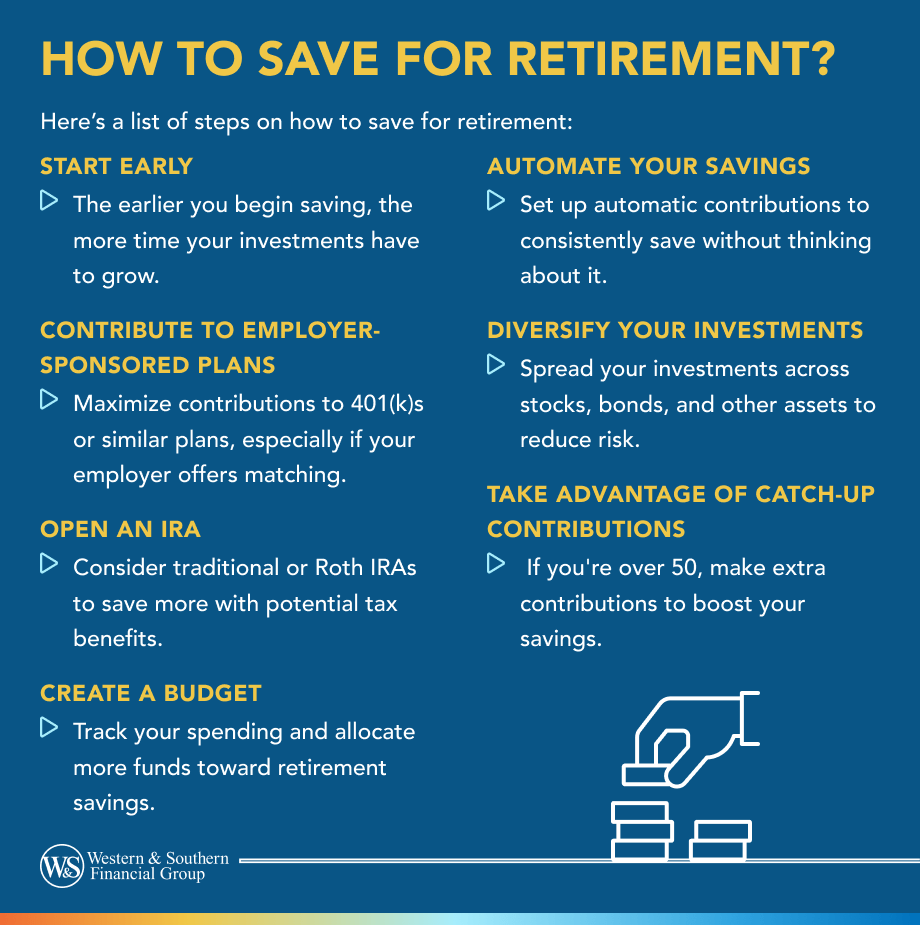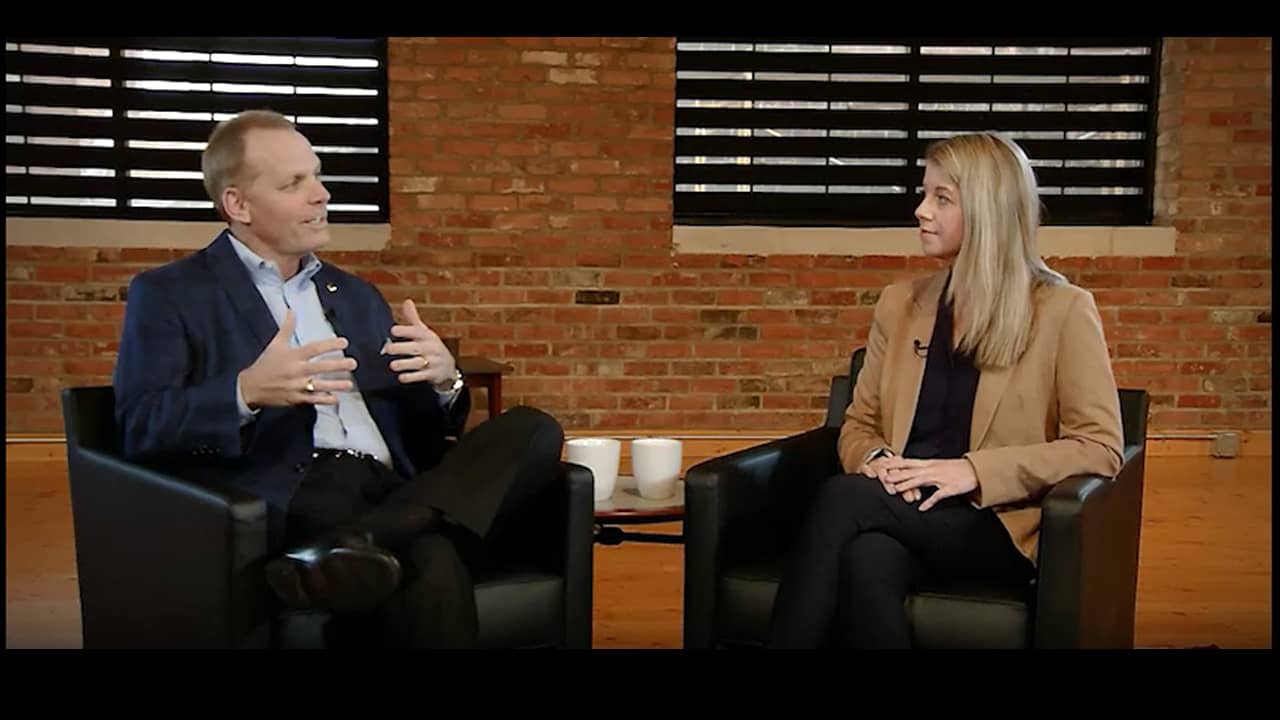Video Transcript
Sarah Weston
Unlike anything before. Social media has really quicken the pace. People everywhere are continuously searching for that proverbial pot of gold, and it's easy to get lost in the shuffle. So before you buy that dream fulfilling item, it's important to think about your own well-being and pay yourself first. Hi, I'm Sarah Weston, host of Road Map for the Future, brought to you by Western and Southern Life.
Today, we're talking about saving. We have with us the President and Chief Marketing Officer, W&S Agency Group, Troy Brodie, to speak to this notion of paying yourself first try. What does that really mean
Troy Brodie
Pay yourself first really is a catchy saying and it's also great advice. And best of all, it applies to all pre-retirement age groups because basically when someone says Pay yourself first, what we're telling you is to allocate funds for retirement before you start doing any discretionary spending. So by setting aside a portion for retirement, you are helping to shore up your financial future.
Sarah Weston
I see. But how realistic is it for you to pay yourself first? So many of us have a lot of financial obligations.
Troy Brodie
That's a great question. And it certainly is realistic. And I think one thing many people find is that they're able to have their retirement allocations handled on their behalf without actually having to write checks or transfer funds. And if you can do that, you tend not to notice it's going towards savings. You don't feel it, and you simply adjust your lifestyle to fit.
And here's what I mean. A great example. Would it be your company's 401k plan? I mean, many employers across the nation offer these. And the first thing you'll want to do is contribute as much as you can and as much as your company will match. And then you can then make it easier on yourself by having the contributions handled directly by the payroll department where you work.
And this way your contribution to your 401k is the first thing that comes out of your compensation as a payroll deduction. In other words, you really are paying yourself first, and chances are after a while you won't even miss it. So to be clear, I'm not advocating not paying your bills. When we say pay yourself first, that would be a problem.
But the key is finding that balance, that right balance, and making sure you're putting the right amount towards savings. And then with what you actually take home, pay your bills and purchase all those necessities that we all have. And then also think about the fun stuff that needs to come last.
Sarah Weston
Is it really that important to do it in that order?
Troy Brodie
Well, let's take a look at that. So say you pay your bills first. Let's take that approach. Pay the bills first. Then we'll look at savings. You're certainly making good on your financial obligations, right? No one would say paying your bills is not a good thing. But should you then start with discretionary spending, the fun stuff, then you're shopping online, dining out and travel.
There's a good chance when all is said and done, you won't have much or anything left to put towards your retirement. So in that instance, you would actually be paying yourself last. So when thinking about paying yourself first, I do think it's important to have balance and to put things into perspective and a story that I've heard that gives balance to this, or at least some perspective, is imagine you're in the movie theater with your family and you're out there to see the best new movie that's in town.
And you've got a lot of people in the theater who are your creditors. There is your mortgage person. There's your dentist who you owe money to. Your creditors are there with their families as well. And if there was an emergency in the theater and people needed to get out, who would you say first? Obviously, your family and your loved ones, and then you would try to help as many others as you can.
And this example only puts into perspective the importance of taking care of yourself and your family before other things. Right now, remember, I'm not saying don't pay your bills. I'm saying you have to pay your bill, but you've got to find that balance and you've got to prioritize some things over others. The theory is you are the most important person in this equation and you're placing a priority on saving.
So really, regardless of your age, set aside funds for retirement before you do anything else. And then, as we say, you're truly paying yourself first.
Sarah Weston
Wow, this is so enlightening. But is it really worth it to use the process of paying myself first? If you can only set aside a small amount for savings.
Troy Brodie
Right. I get that. That's a popular question. And then the answer is yes. And here is why you have to start somewhere. But the key is you got to start allocate whatever it is you feel you can towards retirement. And if you can have it payroll deducted, have it held out of your paycheck so you're not as likely to miss it.
And then in a few months or a year down the road, reevaluate things, change, reevaluate where you stay and take a look at what you've accomplished, what you've accumulated. Take a look at your expenses, and perhaps you can increase your allocation in the first place to look if you're looking for extra money to save. Is that discretionary spending?
Because, look, I get it. Putting away money for retirement is not as exciting as a fun new purchase or taking a trip. But when you do that before you buy anything else, you really are paying yourself first.
Sarah Weston
Well, Troy, thank you so much for your wonderful insight on this topic.
Key Takeaways
- Figuring out how to save for retirement depends on your age. A 20-year-old may use different strategies than a 50-year-old.
- Your savings goals also depend on your income and how much you expect to need in retirement.
- One way to track progress is to compare against average savings by age group. This rule suggests saving 10 years of your annual salary by the time you retire.
- A retirement calculator is another way to set your savings target and check your progress.
- Retirement accounts like 401(k)s and IRAs offer tax breaks to help you save more, but they aren't the only option. HSAs, cash-value life insurance, annuities and brokerage accounts are other possibilities.
Many Americans worry about how to save for retirement and outliving their money. You might think you're saving enough to retire, but what does that really mean? You might say $1 million by the end of your career. Or you might figure that saving enough to replace 70% to 80% of your current income may be enough.
Unless you've carefully mapped out how much to save for your desired retirement lifestyle, you're probably just guessing at what you'll need — and for how long you'll need it.
So how much money do you need to retire? Here's a look at how you can determine your potential retirement needs now to help establish a more secure future.
Figure Out How Much You Need to Save
Figuring out how much to save depends on your income and personal financial goals. One simple way to measure your progress is by using a rule of thumb based on your age and your annual income. This rule recommends:
- By age 30, save up enough to match your annual salary.
- By age 40, save up three times your annual salary.
- By age 50, save up six times your annual salary.
- By age 60, save up eight times your annual salary.
- By the time you retire (around 65), save up 10 times your annual salary.
These are just ballpark estimates for how to save for retirement. The amount you actually need could be more or less. However, these rules give you a target for staying on track. You could also see how you compare against the average retirement balance for different ages.
Determine a Monthly Savings Rate
Naturally, the more you save per month, the more you may have for retirement. Many financial experts recommend building a financial cushion of at least $1 million.
Hitting this target is easier the earlier you start. For instance, if you begin saving $6,000 a year at age 20, earning 8% a year with your investments, you'd have nearly $1.7 million by the time you turn 60. On the other hand, if you waited until age 40 to save the same amount, you'd have less than $300,000 by the time you turn 60.
If you're worried about hitting your retirement goals, consider how you could increase your monthly savings rate. Could you increase your income by working more hours or save more by trimming expenses in your budget? Anything extra you can put aside now can help put you in a better position later.
Choose a Retirement Account
You can use several retirement accounts to build your savings with tax benefits. Each account has its own strengths and weaknesses, as well as specific rules and income restrictions. Keep all of this in mind as you explore how to invest for retirement.
Employer-Sponsored Retirement Accounts
An employer-sponsored retirement account is one you get through work, like a 401(k) or 403(b). You can only invest in these plans if your job offers one. If so, you can send money from your paycheck into the retirement account, deducting whatever you put in from your taxes for the year. Your investments also delay taxes as long as they stay in the 401(k).
Your employer may offer a matching contribution, which is extra money it puts in when you save through the plan. Lastly, you can often save more per year in an employer-sponsored plan than you could with an individual retirement account (IRA) outside of work.
Traditional IRA
If you don't have a 401(k) at work or are unhappy with the investments your employer picked, you could use a traditional IRA. These accounts also give you a tax deduction for putting money in, and your investments grow tax-deferred. Since it's your own personal account, you pick the investments.
Roth IRA
A Roth IRA is another retirement account you open yourself outside of work. With these accounts, you don't get an upfront tax deduction for saving money. In exchange, when you take money out in retirement, you may not owe taxes if you meet certain qualifications. In other words, you don't owe income tax on your investment gains.
With a 401(k) or traditional IRA, your withdrawals are taxable. It's possible your job may offer a Roth version of the 401(k) with similar tax rules as the Roth IRA.
How to Save in Your 20s
When you're in your 20s, retirement can feel like a lifetime away because it is. You may have other financial priorities like paying down your student loans. However, any money you put aside now has the most time to grow and can make it easier to hit your goals later.
If your job offers a 401(k), see whether it offers a match, which is free money from your employer. Ideally, you save at least enough to get it all. Beyond that, anything more you save can put you even further ahead. If possible, consider working a few extra hours a month or cutting back on expenses, like skipping the occasional night out, to save more now. Your future self will appreciate this effort.
Our retirement savings calculator can show you how much a dollar saved in your 20s would grow in the future, which could inspire you to get this valuable head start.


How to Save in Your 30s
In your 30s, your income and career are likely starting to ramp up. If possible, so should the amount you save for retirement. Each year, consider how much more of your salary you could put aside. Push to go beyond the minimum of getting a 401(k) match and try to put even more in your retirement accounts.
If you get a raise, consider how you could put some of that extra income toward your financial goals. Beware of lifestyle inflation where your spending grows as quickly as your income.
It's a good idea to have three years of your annual salary saved up by the time you turn 40. This can help you determine whether you're on track or if you need to save more. Reviewing your budget in more detail can help you find opportunities to save more in your 30s.
Strengthen your retirement plan by adding more to your savings each year. Start Your Free Plan
How to Save in Your 40s
When you reach your 40s, hopefully you've made progress toward hitting your retirement number. Now is not the time to slow down on how much to save for retirement as you move through your career.
Saving in your 40s can be challenging as you might be faced with other financial goals, such as deciding whether to pay for college for your children or taking care of your aging parents. If you do help others, make sure not to cut back on your retirement savings rate. Loan programs can help with college expenses, but not retirement.
If you're worried about where you are with retirement savings, the best course of action is to start saving as much as possible now. Rather than focusing on what you wish you had done in the past, consider how you can put yourself in a better position tomorrow.
How to Save in Your 50s
In your 50s, you're beginning the last major push before the retirement finish line. Once you turn 50, the government allows you to save more money per year in both employer-sponsored retirement plans and IRAs. If you have access to a health savings account (HSA), you could also save more per year in this account once you turn 55.
Using these higher contribution limits could help you reach your retirement goals, especially if you're worried about coming up short. With retirement approaching, you could start thinking about when you'd like to retire. While you could start taking Social Security at age 62, delaying retirement past then increases how much you receive from the government each year. It can also give you more time to save.
How to Save When Close to Retirement
When you're at the retirement finish line, think about how you could finish your career on a strong note. You still have access to the catch-up contributions for both workplace retirement plans and IRAs. As a result, you can put aside more per year in these accounts than when you were younger. Review your budget and think about how you could get as close to maxing out as possible.
Consider what retirement might look like for you. Would you be willing to work part time for a few years at this point in your life? Even an extra bit of income can take pressure off your savings and make it easier for your money to last.
Calculate How Much You Need to Retire
Figuring out how much you need to retire is a personal decision, though you can use some general strategies for guidance. You could create your personal retirement budget based on your expected lifestyle, location, living expenses, and health. Once you know how much you expect to spend per year, you can then estimate how much you'd need saved up to cover this spending.
The 4% rule is one popular theory. It says you can safely withdraw 4% of your starting retirement financial cushion and keep taking that amount each year (adjusted for inflation) without running out for 30 years. If you expect to need $40,000 a year in investment income at the start of retirement, you'd need $1 million to retire under this rule.
Figuring out how much you need is an art and a science. You could use other methods to set your budget and goals for how much to save.
Adjust Your Investments
Market fluctuations can significantly affect your retirement savings, especially as you near retirement. While younger investors can benefit from downturns, major losses close to retirement can be difficult. Transitioning to a conservative portfolio, with more bonds and fewer stocks, can help protect your savings.
Early on, a stock-heavy approach promotes growth, but later losses are more detrimental due to a larger portfolio. This strategy also mitigates sequence of return risk, where market drops coincide with withdrawals, jeopardizing your savings. By adjusting investments wisely, you can secure a more stable financial future.
Bottom Line
The primary reason to save for retirement is to help provide financial security later in life — and it's not too early (or too late) to start saving for retirement. There are certain considerations, such as choosing the right retirement accounts and knowing approximately what percentage of your income to save for your age, that can help you succeed.
Unless you expect to win the lottery or inherit millions of dollars, you need sufficient savings to pay for living expenses after leaving the workforce. If you're looking for more information on how to save for retirement, consider reaching out to a financial professional, who can offer personalized insights and guidance designed to suit your individual needs.
Small steps now can lead to big savings for your future retirement. Start Your Free Plan
Frequently Asked Questions
What’s the best way to save for retirement?
There's no one-size-fits-all way to save for retirement. Instead, there are several different options, each with pros and cons. The most popular way to save is by using retirement accounts, such as a 401(k) at work or an IRA outside of work. These accounts offer tax breaks to help you put money aside for the future. Other ways to save include:
- A brokerage investment account
- Your personal bank savings account, money market accounts and certificates of deposit (CDs)
- Cash-value life insurance
- Health savings accounts (if you have a high-deductible health insurance plan)
- Annuities
Your retirement savings plan could include a combination of these approaches. For example, you could invest in stocks for growth using your 401(k), and then use whole life insurance to build cash value with a guaranteed return while covering your insurance needs. That way, you get to combine the benefits of both accounts.
Whichever approach you use, confirm you're saving enough to be on track for your future retirement target. Using a retirement calculator or speaking with a financial professional can help you figure this out.
What’s the safest way to save for retirement?
Several savings options offer a guaranteed return with little to no risk of losses. Some possibilities include:
- Bank CDs, money market accounts and savings accounts
- Whole life insurance
- Fixed annuities
- Federal government bonds
Keep in mind that investing is usually a trade-off between risk and return. Very safe accounts may not earn as much as investments like stocks and mutual funds. With market investments, short-term losses are possible, but the historical long-term average return is higher. If you save for retirement using only very safe accounts, you may need to save more per year to make up for earning less from investing.










